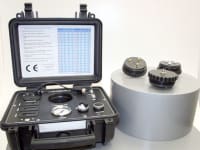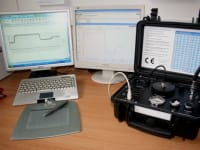CCUBA (rebreathers) use oxygen cells to monitor the gas content that the diver breathes. This process is critical to the primary function of the life support system, and is also the weakest link in that control system. Oxygen cells behave in a similar way to electrical batteries in that they have a finite lifespan which is dependent upon use. The reaction of oxygen on the cell creates an electrical output that has a predicted voltage which is dependent on the materials used. In theory they should give that voltage from the day they are made until they are exhausted, but this is often not the case.
Failures in cells can be life threatening for technical divers and in particular, rebreather divers. The failure modes common to these cells are: failing with a higher than expected output due to electrolyte leaks, current limitation due to exhausted cell life and non linear output across its range.
Preventing accidents in rebreathers from cell failures is possible in most cases by accurately testing the cells before use. The only way to accurately test a cell is with a calibrated test chamber which can hold a static pressure without deviation and the ability to log the results and graph them.
Current limitations and none linearity of galvanic oxygen cells has been a problem for rebreathers from the start and has caused a number of fatalities. This fact pushed the Narked at 90 team to try and minimize the problems encountered on dives with current limited cells.
So they came up with the CELL CHECKER. It has passed all the CE requirements and is now in production. So now you can check your cells for current limiting ‘before’ you get in the water.
“Calibration on the surface can only produce an output from the cells for 1 bar PPO2. Diving at a set point greater that 1.0 will put you at risk of Hyperoxia unless you can verify the cells integrity,” he explained.
He went on to say, “Usually this involves an Oxygen flush at 6m depth and watching the cells are linear and not current limited. Doing this after a dive or whilst doing deco is too late and can be tricky at the beginning of a dive if the current is flowing or you're pressured into a fast descent. You end up in a situation of inaccurate readings that will not tell you if your cells are capable of maintaining their output over a period of time without dropping off.”
We firmly believe it will save lives or at the very least ensure the rebreather will be fitted with components that won’t fail mid-mission.
The Cell Checker shows you true milli-volt readings from the cells, so does not need to be calibrated as a PPO2 readout will need to be, making the unit very easy to use.
Years have been spent developing the system and the vast amount of research into cell safety have allowed us to help many manufacturers to improve their cells.
Like this entry?
-
About the Entrant
- Name:Brent Hudson
- Type of entry:teamTeam members:Brent Hudson
John Routley - Software used for this entry:Solidworks
- Patent status:none








